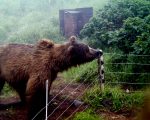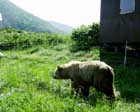
Image & Excerpt from Charlie's
July 20th, 1998 - Diary Entry
"However a old female wandered through by the cabin only a few minutes
ago so I grabbed the camera and took a picture of it one second
before it got a shock from the fence. This was obviously an animal who
hadn't been educated to the jolt previously (not surprising as there are
hundreds of bears in the area). She let out a big snort and ran away,
looking over her shoulder for whatever it was that hit her."

Biscuit around the plane's fence.

Biscuit feeling quite comfortable around the plane and
the fence but maintaining a distance from
the fence.

Biscuit around the campsite's fence.
(Click on any Image to see a higher resolution version)
Our compost is a hole dug in the ground with a wooden lid on it. Last year we decided to empty the dirt-like remains from the pit and put the well composted remains quite a ways from camp. Within a day a bear had discovered it, and rolled in it with great delight. However, the much fresher stuff in the pit at the end of a summer's use, remains absolutely untouched during the fall where it tantalizingly exists a foot inside the fence. We know bears wander close by as our cabin is in the middle of their prime pine-cone harvesting ground.
We leave the wires of the fence in place when we leave in the fall. Snow pushes posts down over the winter and many of the wires are on the ground when we return but no bear has stepped over them. Our friend Alexei at the fish science station, where we contributed an electric fence in 1997, describes a very amusing but telling story which I have told before but it deserves a re-run. Their fence around the station is also inactive and buried under many feet of snow during the winter. One spring he watched a bear, newly emerged from its den, approach the station. When it came to where the fence lay beneath the snow, it carefully walked a foot away around the perimeter of the entire place. Judging from how everything stays untouched here, over the winter, similar protocol seems to be observed. We have described watching bears not knowing electricity go and sniff our fence and when touching it, jumping back as they receive a jolt. Once is enough and never again do they want to repeat the experience. In fact any sign of wire spells keep away after one jolt. When our cubs were really small, they tested the system to its limit, living beside our cabin in an area enclosed by 4 strands of wire. They learned that they could crawl under it where only their hair touched the fence, thereby avoiding a shock. Quickly we added another wire against the ground but did not link it to the electric current because it would short out. The cubs would not even approach that wire and thus stayed enclosed for the duration of their time in captivity before their release.
In order for a shock to be transmitted from the fence where up to 3,000 volts pulse at one- second intervals, a ground must be accomplished. Either a person or a bear needs to be standing on the ground or somehow touching it. If a ground is established continuously with the fence unit by a wire shorting out on the ground or a bunch of grass growing against it, the batteries drain quickly. We are constantly asked the question if the bear will be hurt by the jolt. I accidentally hit the fence all the time and it hurts enough to cause be me to be very careful. It is very startling but not damaging. High voltage alone, does not burn or cause lasting injury. It is the amperage factor of electricity that causes burns, paralytic vibrations and becomes deadly. Electric fence units have extremely low amperage.
It is interesting for us that the bears hold us no hard feelings about the fence. Some adverse conditioning, such as use of rubber bullets, must cause some bears to feel angry towards man. They are so sensitive and have such accurate memories for all details including who delivered what injury. But for the fence unit, they don't seem to directly associate it with us It is their action which causes the pain as opposed to something directly delivered by man such as a rubber bullet or which they know the source.
Yesterday, we returned from a filming excursion out on the lake to see that Biscuit was approaching our camp to say hello to us. I have no recent photos of her in the vicinity of the fence, so was delighted to jump out of the boat and take some images. You will note in the photos attached that she stays away from the fence but is not afraid to be in its vicinity. We have observed this behavior with her and other bears for several years now. They see it, know about it, avoid going near it and otherwise it doesn't interfere with their movement.
We have an ongoing experiment around our outdoor toilet to see what is minimally required in number of wires of a fence. For 4 years now we have had one wire one foot off the ground. No bear has venture over it although one accidentally ran through it as it is a bit obscure from one approach through the pines. But regardless, nothing has ever touched our toilet since we put it up.
We have described at length how Charlie connects one wire to his airplane. No bear around here goes near his plane.
The system around our camp needs some explanation. We have two sources of energy. One is from two solar panels and the other from our windmill; both of which we pack up every fall. From the panels or the windmill, variable strengths and amounts of energy go via a regulator to three Gel Cell, Deep Cycle Batteries where it is stored. The regulator is essential as it controls the flow and amount of electricity to the batteries. For example when the batteries are almost full, the amount is slowed down or even stopped by the regulator. This happens often in a very high wind when the windmill is producing far more electricity than the batteries can hold without damage. The batteries deliver a steady flow of 12Volt power to a small box in the cabin called an Energizer. This transforms it from 12Volt to the higher energy pulse that is sent out along the wires surrounding our camp and a satellite fence around the airplane.
The energizer has a second critical wire that goes to the ground rod. We drove a metal galvanized rod 6 feet into the ground by the cabin for this purpose. There is another component with a switch which enables us to turn the current on or off around the cabin. It ticks away like a metronome all night assuring us thereby that all is functioning. We turn it off when in camp often as for some strange reason we get a small shock off of our satellite phone when the fence is on, probably because the cabin is covered in metal. We feel strongly that one of the most important aspects of our research here, in terms of direct application of how to live with bears nearby, is the use of an electric fencing system. It could be used by acreage owners around bird feeders, by horse outfitters, in fish camps, by campers etc. We plan to produce a "How To" booklet with a short video and include the concept for the backpackers lightweight electric fence unit. I have been wanting to develop this for some time and think the funding may be in place to do so this fall. A group of Russian guides have volunteered to test the prototype extensively in 2002. I hope to find more volunteers in Canada. After a year of testing the backpackers unit, the booklet and video would be available for publication in 2002.
- Maureen